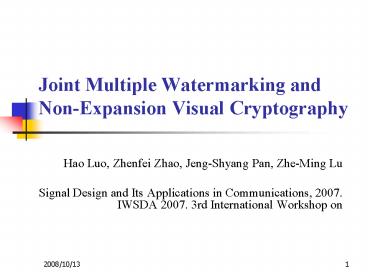Joint Multiple Watermarking and Non-Expansion Visual Cryptography - PowerPoint PPT Presentation
1 / 23
Title:
Joint Multiple Watermarking and Non-Expansion Visual Cryptography
Description:
Joint Multiple Watermarking and Non-Expansion Visual Cryptography Hao Luo, Zhenfei Zhao, Jeng-Shyang Pan, Zhe-Ming Lu Signal Design and Its Applications in ... – PowerPoint PPT presentation
Number of Views:50
Avg rating:3.0/5.0
Title: Joint Multiple Watermarking and Non-Expansion Visual Cryptography
1
Joint Multiple Watermarking and Non-Expansion
Visual Cryptography
- Hao Luo, Zhenfei Zhao, Jeng-Shyang Pan, Zhe-Ming
Lu - Signal Design and Its Applications in
Communications, 2007. IWSDA 2007. 3rd
International Workshop on
2
Outline
- Introduction
- Conventional 2,2 VSS
- Proposed scheme
- Experimental results
- Conclusions
3
Introduction(1/3)
- Visual cryptography a technique of encrypting a
two-tone secret image into a set of binary
transparency images which look like random noise. - Visual secret sharing scheme based on a
?k,n?-threshold framework. - A secret image is encrypted into n transparencies
distributed to n participants. - Only when k or more than k transparencies are
stacked, content of the secret image is visible.
4
Introduction(2/3)
- Fang et als scheme has following properties
- As the input secret image is a halftone image, it
can not be directly used for gray level images. - Only one watermark is embedded in two
transparencies. - The secret sharing model used is the conventional
?2,2?-threshold VSS. - It will greatly places heavy loading for the
limited network bandwidth and the storage space.
5
Introduction(3/3)
- To improve the inefficiencies of Fang et als
method - The input secret image is a gray level image
instead of a halftone image. - There are two watermarks instead of one are
embedded and thus the hidden data capacity is
enhanced. - A non-expansion visual secret sharing model
instead of the conventional ?2,2?VSS model is
used, and the size of shares is equal to that of
the secret image.
6
Conventional?2,2?VSS(1/2)
Fig. 1. Codewords of ?2,2?VSS
7
Conventional?2,2?VSS(2/2)
(b) the first transparency 512x512
(a) secret image 256x256
(c) the second transparency 512x512
(d) stacking result 512x512
8
Proposed Scheme(1/10)
Secret image
Error diffusion Half-toning
Watermark W1
Visual secret sharing
Watermark W2
Watermarked Share image S1
Watermarked Share image S2
Watermark embedding and secret image encryption
9
Proposed Scheme(2/10)
Watermarked Share image S1
Watermarked Share image S2
Watermark W2
XOR operation
Watermark W1
Watermarked halftone image
Watermark extraction and secret image decryption
10
Proposed Scheme(3/10)
- Watermark embedding in half-toning
- The secret image S is scaled into a half sized
image k1k2/2 HS.
11
Proposed Scheme(4/10)
- HS is used as the input image of error diffusion
half-toning.
W1
12
Proposed Scheme(5/10)
w
b(i,j)0 or 255
u(i,j) x(i,j)-x(i,j)
Threshold t(i,j)128
?
x(i,j)
-
x(i,j)
-
?
Kernel K
ei,j bi,j- ui,j
Watermark (W1) embedding in halftoning
13
Proposed Scheme(6/10)
- Watermark embedding in encryption
Encryption and decryption strategy
14
Proposed Scheme(7/10)
c1
c2
Codewords of non-expansion VSS
W2
B11
B12
B22
B21
15
Proposed Scheme(8/10)
Watermark 0 1 1 0
16
Proposed Scheme(9/10)
- W2 extraction XOR(B11,B22)
1 1 0 W2
XOR
0
XOR
XOR
17
Proposed Scheme(10/10)
- W1 extraction
- Based on the perfectly reconstructed watermarked
halftone image. - To find the selected pixels positions using the
pseudo random number generator with the same key.
- Retrieve the pixel values in these positions and
rearrange it into a binary sequence.
18
Experimental results(1/3)
W1 32x32 ( binary image )
W2 256x512 ( binary image )
19
Experimental results(2/3)
Secret image 512x512 ( Gray level image )
The halftone Lena with watermark KUAS embedded
20
Experimental results(3/3)
Transparency images T1,T2( 512x512 )
Stacking result
Extracted watermarks
21
Conclusions
- Proposes a scheme to hide two watermarks in
transparencies of visual cryptography. - Watermark extraction is simple for only XOR
computations of two transparencies are needed.
22
References(1/2)
- 1 M. Naor and A. Shamir, Visual cryptography,
Eurocrypt94, Lecture Notes in Computer Scienece,
Vol. 950, pp. 1-12, 1995. - 2 C.C. Lin, W. H. Tsai, Visual cryptography
for gray-level images by dithering techniques,
Pattern Recognition Letters, vol. 24, pp.
349-358, 2003. - 3 C. Blundo, Santis A De. and M. Naor, Visual
cryptography for grey level images, Information
Processing Letters. vol. 75(6), pp. 255-259,
2000. - 4 D. Jin, W.Q. Yan and M.S. Kankanhalli,
Progressive Color Visual Cryptography, Journal
of Electronic Imaging, vol. 14(3), 2005.
23
References(2/2)
- 5 J. S. Pan, H.C. Huang, and L.C. Jain,
Intelligent Watermarking Techniques, World
Scientific Publishing Company, Singapore, 2004. - 6 W. P. Fang and J.C. Lin, Visual Cryptography
with Extra Ability of Hiding Confidential Data,
Journal of Electronic Imaging, vol. 15(2), 2006.































